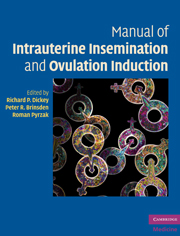Book contents
- Frontmatter
- Contents
- List of contributors
- Preface
- 1 An overview of intrauterine insemination and ovulation induction
- 2 Male causes of infertility: evaluation and treatment
- 3 Female causes of infertility: evaluation and treatment
- 4 Clinic and laboratory design, personnel and equipment
- 5 Semen analysis: semen requirements for intrauterine insemination
- 6 Semen preparation for intrauterine insemination
- 7 Ovulation induction for intrauterine insemination I: oral drugs clomiphene, tamoxifen, letrozole
- 8 Ovulation induction for intrauterine insemination II: gonadotropins and oral drug–gonadotropin combinations
- 9 Ultrasonography in the management of ovulation induction and intrauterine insemination
- 10 Insemination technique and insemination complications
- 11 Cryopreservation
- 12 Donor sperm
- 13 The role of the nurse in intrauterine insemination and ovulation induction
- 14 Complications of ovulation induction I: high-order multiple births, miscarriage, ectopic pregnancy, congenital anomalies, ovarian cancer
- 15 Complications of ovulation induction II: ovarian hyperstimulation syndrome, ovarian torsion
- 16 The psychological issues of intrauterine insemination
- 17 Ethical, legal and religious considerations of artificial insemination
- Index
9 - Ultrasonography in the management of ovulation induction and intrauterine insemination
Published online by Cambridge University Press: 01 February 2010
- Frontmatter
- Contents
- List of contributors
- Preface
- 1 An overview of intrauterine insemination and ovulation induction
- 2 Male causes of infertility: evaluation and treatment
- 3 Female causes of infertility: evaluation and treatment
- 4 Clinic and laboratory design, personnel and equipment
- 5 Semen analysis: semen requirements for intrauterine insemination
- 6 Semen preparation for intrauterine insemination
- 7 Ovulation induction for intrauterine insemination I: oral drugs clomiphene, tamoxifen, letrozole
- 8 Ovulation induction for intrauterine insemination II: gonadotropins and oral drug–gonadotropin combinations
- 9 Ultrasonography in the management of ovulation induction and intrauterine insemination
- 10 Insemination technique and insemination complications
- 11 Cryopreservation
- 12 Donor sperm
- 13 The role of the nurse in intrauterine insemination and ovulation induction
- 14 Complications of ovulation induction I: high-order multiple births, miscarriage, ectopic pregnancy, congenital anomalies, ovarian cancer
- 15 Complications of ovulation induction II: ovarian hyperstimulation syndrome, ovarian torsion
- 16 The psychological issues of intrauterine insemination
- 17 Ethical, legal and religious considerations of artificial insemination
- Index
Summary
Introduction
Ultrasound (US) is an essential part of infertility evaluation of the female, and is indispensable for obtaining optimal results from intrauterine insemination (IUI) and ovulation induction (OI). Use of US for evaluation and management of infertility is of recent origin. The first report of follicle changes throughout a complete menstrual cycle appeared in 1979. Sonohysterography (SHG), instillation of sonolucent fluid into the uterus in order to improve visualization of the fallopian tubes and soft tissue abnormalities of the uterine cavity, followed in 1984. Recent developments include the use of three-dimensional US to delineate uterine structural abnormalities, and the adoption of color Doppler blood-flow analysis of uterine and ovarian blood vessels.
Transabdominal ultrasound (AUS) is the preferred method for evaluation of pelvic masses larger than 5 cm, and for evaluation of the pregnant uterus after the first trimester. Transabdominal US requires a distended bladder, which is uncomfortable for the patient, particularly when pressure is applied on the lower abdomen during scanning. Accurate delineation of pelvic structures is not possible in all women due to beam scatter by excessive subcutaneous fat and overlying gas-filled bowel loops, or when the ovaries and uterus are located deep in the pelvis. Transabdominal US utilizes frequencies between 2.5 and 3.5 MHz. As frequency is increased, imaging depth decreases and ambiguity occurs because of attenuation. For soft tissue, attenuation in decibels (dB) is approximately 0.5 dB per cm for each MHz of frequency.
- Type
- Chapter
- Information
- Manual of Intrauterine Insemination and Ovulation Induction , pp. 93 - 108Publisher: Cambridge University PressPrint publication year: 2009



